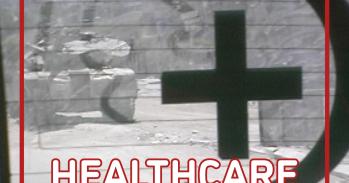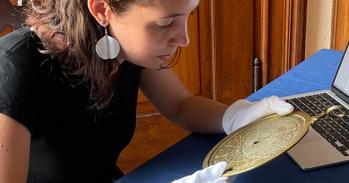
As the birthplace of Fascism – and both ally and victim of Nazi Germany – Italy presents a particularly complex case study of how countries came to terms with the catastrophic events of the Holocaust after the war. Robert Gordon’s new book charts the cultural fault lines that emerged as it slowly learned to acknowledge its part in the tragedy.
As the birthplace of Fascism – and both ally and victim of Nazi Germany – Italy presents a particularly complex case study of how countries came to terms with the catastrophic events of the Holocaust after the war. Robert Gordon’s new book charts the cultural fault lines that emerged as it slowly learned to acknowledge its part in the tragedy.
Encounters with the Holocaust can change the way we perceive ourselves.
Professor Robert Gordon
As the generation that witnessed the twin horrors of the Holocaust and World War II slips away, some have begun to fear that the devastating lessons of our recent history may grow faint with its passing. In the case of the Holocaust in particular, however, the level of remembrance seems remarkably high, as a profusion of memorials, museums, annual commemoration events and the mandatory study of the ‘Shoah’ on national curricula around the world attest.
It is difficult to believe that this was not always the case. At the end of World War II, what we now call the Holocaust was far from a matter of general discussion. Attention was focused on Allied victory and the building of a post-war world. What had happened in the camps was subsumed into that general narrative. The Italian Auschwitz survivor Primo Levi, later wrote: “At that time, people had other things to get on with: building houses, looking for jobs… People didn’t want to hear [about the camps], they wanted other things.”
Levi is a recurring figure in Robert Gordon’s new book, The Holocaust in Italian Culture, 1944–2010, which explores how Italians have handled the memory of the Holocaust, but also the war, which intersects with it in unpredictable ways. Both are intertwined aspects of a global human tragedy, but in Italy this takes on particularly complex and troubling dimensions, because it was a former Fascist state and Nazi collaborator.
Researchers like Gordon have come to understand that the Holocaust was not the subject of sudden public concern at the war’s end. Instead, most countries handled the cataclysm with an initial stance that almost resembles disregard. This was followed by a period of rediscovery in the 1950s and 1960s, and then growing awareness that peaked in the 1990s. Now, the Shoah is a general aspect of world history, perhaps the defining event of the 20th century, to some extent decoupled from the local contexts in which it was acted out.
Each country, however, also has its own story to tell and its own paths to memory. Surprisingly, how post-war Italy confronted, or at times failed to confront, its participation in the genocide has never been addressed by a major study. Gordon, a specialist in Italian culture, argues that by mapping cultural output about the Holocaust we can see how the nation’s response to the catastrophe shifted over time. Through it, we see not just Italy’s take on its Fascist past, but its engagement with the anti-Fascist Resistance, Cold War politics, the Church, Europe, immigration and multiculturalism.
“Encounters with the Holocaust can change the way we perceive ourselves,” Gordon said. “In the 1960s, an Italian schoolchild might have read Anne Frank or Primo Levi. From the 1990s, class trips to concentration camps became common. Many children never forget this first contact, and even if they don’t study it further, it comes to define their understanding of history, of their country and their identity.”
Italy has made a significant cultural contribution to making the Holocaust a ubiquitous presence in our culture. Best known are the works of Levi, and the Oscar-winning 1997 film by Roberto Benigni, Life is Beautiful. Beyond these, however, lies a rich seam of less familiar first-hand accounts, works of fiction, poetry and drama, films and documentaries, television programmes, art, music, and architecture, museums, galleries and cultural events.
However, as in other nations, social and cultural recognition of what had happened started slowly in Italy. At the end of World War II, floods of people returned and the Jews were treated as part of a more general category of ‘The Fallen’ or the survivors, rather than as a special case.
The dominant local narrative stressed that the deportation of Jews had happened under the Germans, after the Italian government capitulated in 1943, and was a policy resisted by Italians themselves. “In 1945, the country wanted to be seen as a victim,” Gordon said. “It wanted to get into the UN. The myth was propagated that the average Italian on the street had not wanted Fascism, had deep down been a decent person and was not really racist.” Jews themselves, returning from the camps, saw little social value in exposing the crimes of their neighbours. They, too, wanted to rebuild.
The step-change came at the end of the 1950s, with the emergence of new first-hand accounts, such as those of Edith Bruck and Emilio Jani, historical reassessments by the likes of Renzo de Felice, and films such as Carlo Lizzani’s The Gold of Rome (1961). Amid global reawakening about the Holocaust, triggered by the trial and execution of Adolf Eichmann, a new sense of responsibility to consider what had happened, and – eventually, Italy’s part in the process – began to gain momentum.
As the space between the terrible events of the Holocaust and the present expanded, more people felt able to cope with personal accounts from the camps. Levi’s If This is a Man had sold few copies when first published in 1947, but in 1958 a new edition boosted his reputation, which was then cemented by The Truce (1963). Such personal accounts, however, proved that the Holocaust could not be seen purely as a Nazi crime. The notion of Italian involvement was slowly gaining acceptance.
In the 1980s, a new generation of historians who believed that Italy was not telling enough of the truth about its wartime experience changed the picture again. Researchers began to reveal a network of Fascist concentration camps that had existed in southern Italy but had been largely forgotten. What followed was an outpouring of engagement with the Holocaust, boosted further by the fall of the Soviet Union, which enabled visits to sites such as Auschwitz.
Filmmakers, artists, architects and intellectuals had contributed to each of these waves of attention. They included authors such as Giorgio Bassani and Natalia Ginzburg, and directors such as Vittorio De Sica, Lina Wertmuller and Francesco Rosi. Many were determined to show specifically Italian aspects of the Holocaust, often in advance of wider acceptance of Italian involvement. In 1997, Benigni released Life is Beautiful and Rosi a film version of The Truce. “The conjunction of these films, both in their way focused on the specifics of an Italian inflexion to the history and experience of the Holocaust, is of cardinal importance in reading the cultural sensitivities of the moment,” Gordon writes.
The crescendo built towards the first official Holocaust Memorial Day in Italy, its ‘Day of Memory’ in 2001, which Gordon calls “the high-water mark of the entry of the Holocaust into national public life in Italy.” The event certainly showed how far the country had come in its acknowledgement of the Shoah, explicitly recognising the persecution of its own Jewish citizens and their deportation, as well as participating in an international commemoration.
Yet ambiguities still remained. The label ‘Day of Memory’ was deliberately neutral, and the date chosen, January 27th, was deliberately that of the anniversary of the liberation of Auschwitz – a date of international importance, certainly, but not specific to Italy.
In the 21st century, for the generation after Life is Beautiful and Schindler’s List, the Holocaust is part of a shared, global history. At the same time, its local history still presents problems. Italy’s part in perpetrating the tragedy is now a matter of widespread recognition and cultural reflection. But even now, the same nation occasionally struggles to place this awkward and terrible chapter within its shared national story.
The Holocaust in Italian Culture, 1944–2010, by Professor Robert Gordon, is published by Stanford University Press.
For more information, please contact Tom Kirk (tom.kirk@admin.cam.ac.uk) at the University of Cambridge Office of External Affairs and Communications.
This work is licensed under a Creative Commons Licence. If you use this content on your site please link back to this page.





